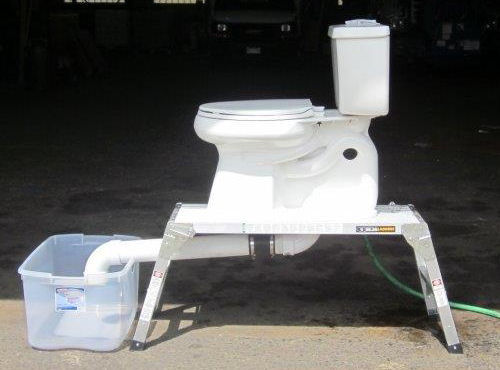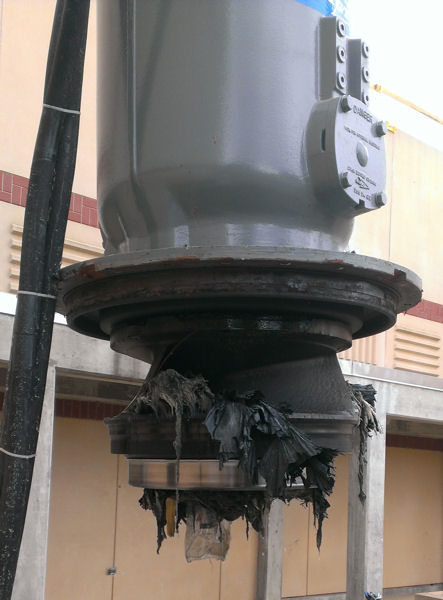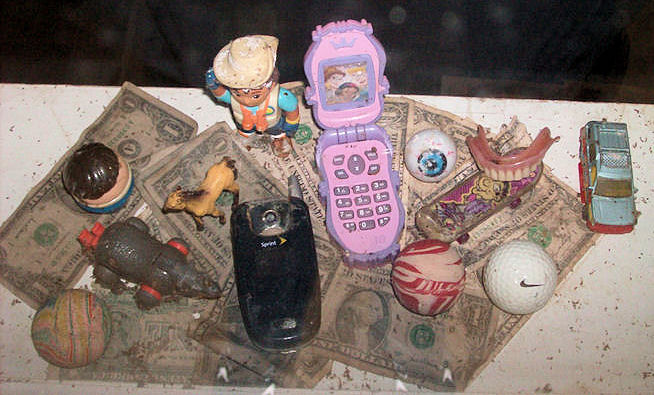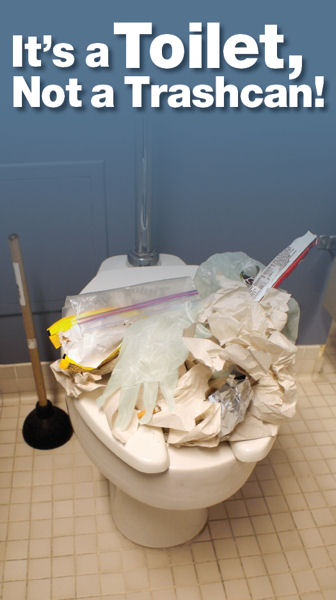
Robert Villée, Plainfield Area Regional Sewerage Authority (Middlesex, N.J.) executive director, worked with authority staff to test flushable-product claims using this system. Photo courtesy of Villée.
Wastewater treatment systems operate 24-hours a day, 7-days a week — that is, until an item that doesn’t belong makes its way into the system, clogging pipes and causing headaches for operators.
Defining nondispersibles
Perpetrators mucking up the system are known as “nondispersibles,” which currently means anything other than human waste and toilet paper that’s flushed down the toilet, explained Robert Villée, Plainfield Area Regional Sewerage Authority (Middlesex, N.J.) executive director and Water Environment Federation (WEF; Alexandria, Va.) Collection Systems Committee (CSC) Flushables Task Group member.
“The industry reference for dispersability is two-ply toilet paper … [which] starts to break apart when the toilet is flushed and is indistinguishable in the wastewater system in a matter of seconds,” Villée said. Anything labeled as flushable should start to break apart during the flush and completely disperse within 5 minutes, he added. “Our mantra is, ‘It’s not flushable if it’s not dispersible,’” Villée said.

A DC Water (Washington) pump clogged by nondispersible items flushed down the toilet. Photo courtesy of Hiram Tanner, DC Water manager.
Only the wastewater industry uses this definition; manufacturers will label any product capable of making it through a home’s plumbing system as flushable, explained Hiram Tanner, DC Water (Washington) manager and WEF House of Delegates (HOD) Nondispersible Workgroup member. But in collection systems, treatment plants, and septic systems, nondispersibles clog pumps, pipes, and valves; overwhelm screens and bar racks; and block sewer mains. They can cause sanitary sewer overflows and require expensive repairs and replacement of pumps, screens, and other equipment, Tanner said.
Nondispersible items also cause problems in private plumbing systems; they can cause sewers to back up into basements, leaving homeowners holding the bill for costly repairs, said Aubrey Strause, Verdant Water PLLC (Scarborough, Maine) owner and CSC Flushables Task Group member.
Misleading or absent labels compound the problem

A senior mechanic performs routine dragging in an Orange County Sanitation District lift station pump. Photo courtesy of Ingrid Hellebrand, Orange County Sanitation District.
The problem of nondispersibles in wastewater treatment systems has grown as more people use and flush such disposable toiletries as baby wipes, cotton swabs, and household cleaning wipes. One reason these nondispersible items end up in toilets is because they are mislabeled, Strause said. She explained that consumers often unknowingly flush items that collection systems can’t handle because of product packaging:
- Words such as “biodegradable” imply that a product can be flushed.
- Labels may lack or obscure the “no flush” logo created by manufacturer standard via the International Nonwovens and Disposables Association (INDA; Cary, N.C.).
- Products may erroneously label nondispersible items as flushable.
Devising an action plan
“The core need is to educate the public that things that don’t act like toilet paper should not be flushed,” Strause said. Consumers can encourage change by educating each other and bringing complaints to the attention of manufacturers, she added.
The wastewater sector should work proactively to drive changes, taking the lead to develop standards for what’s flushable, Strause said. “We need to define dispersability from a wastewater utility perspective,” Villée said. Also needed is a transparent and independent test that mimics wastewater treatment operations and confirms flushability; this “will be the cornerstone of any future legislation,” Villée said.
Next would come uniform labeling standards for products. “Nondispersibles should have ‘Do Not Flush’ prominently displayed on the front of a package,” Villée said. Often, consumers do not see labels on products, and many products do not include a label because existing standards are guidelines and not requirements. Government officials must be asked to enact laws to help eliminate the problem, Villée said.

Nondispersibles found in the Kennebec Sanitary treatment District (Waterville, Maine) system during a facility inspection. Photo courtesy of Aubrey Strause, Verdant Water PLLC (Scarborough, Maine) owner.
“Industry can educate their customers to the deleterious impact they have on the wastewater industry, which will eventually impact rates,” Tanner said. Citizens and sector leaders should encourage their national and local politicians to pass laws prohibiting discharge of products into the collection system, he added. Federal-level regulations will be more effective than state-by-state regulations and much more effective than the current voluntary guidelines for manufacturers, Strause said.
Hopefully, with laws and consumer support, manufacturers will address the issue and develop “products that truly break down in a way similar to toilet paper,” Strause said. “This technology exists and is fully possible to implement; it just needs to be made cost-effective.”
WEF and Member Associations tackle the problem
Fixing the nondispersibles problem “will require a coordinated national effort” in which WEF works with other organizations in both the water and wastewater arenas, Strause said. While the challenges seem daunting, WEF members and WEF Member Associations (MAs) have started this work and recently have been gaining momentum.
WEF, the National Association of Clean Water Agencies (Washington, D.C.), and the American Public Works Association (Kansas City, Mo.) have approached the issue together. The three organizations are working to build consensus on flushable standards, educate the public about the problem, and compile information on regional efforts in North America to solve the problem, Strause said. “The next step will be for these national groups to lead the development of a definition of ‘flushable,’” she added.
WEF also has obtained permission to put the video “Will It Flush?” (produced by the City of Spokane [Wash.] Department of Wastewater Management ) on WEF’s YouTube Channel.
The CSC Flushables Task Group has been working to solve the problem since 2010; and at WEFTEC® 2012, the HOD Nondispersibles Workgroup was formed. “HOD is tasked with supporting the CSC by getting the MAs involved and supporting efforts to bring pressure on the nonwoven fabric industry to change business as usual,” Tanner said. Tanner explained that the HOD group is collecting and compiling information on incidents caused by nondispersibles into a database, so the information can help encourage legislators to act.

The Water Environment Federation (Alexandria, Va.) Collection Systems Committee has helped develop outreach materials including this “It’s a toilet not a trash can” bill stuffer. Click to read more details.
The CSC has been discussing the issue with INDA, which is working to develop the third edition of the Flushability Guidance Document that will set guidelines describing steps that products have to pass before being labeled as “flushable,” Villée said.
In addition, the CSC has helped develop WEF outreach materials, including bill stuffers and fact sheets. Both the CSC and HOD groups have worked together to develop the Flushable or Not? Dispersing the Non-Dispersible Problem webcast, scheduled for June 19, to educate about the topic. A recording of the no-charge webcast will be made available after the event.
Independently, WEF CSC members have been spreading the word on nondispersibles. They have been giving presentations at conferences and events across the country, as well as sending letters and information to and discussing the issue with government, manufacturer, and industry leaders.
Villée has even been working to put manufacturers’ flushable-product claims to the test. He has assisted in two field studies in Portland, Maine, to see if flushable products are dispersing in sewer lines, he said. In addition, he recently worked with Plainfield Area Regional Sewerage Authority staff to test flushable-product claims. He found that “flushable” wipes took an average of 10 flushes before pieces started to break off, and one piece remained intact for 100 flushes, he said.
WEF Member Associations also have been working on the issue. The New England Water Environment Association recently released the position paper Management of Non-Dispersibles in Wastewater.
— Jennifer Fulcher, WEF Highlights








June 12, 2013
Featured, WEF Resources & Efforts